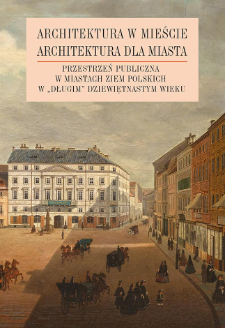
Object
Title: Uniwersalne i lokalne aspekty obiektów reprezentacyjnych w przestrzeni miast habsburskich : dwa przypadki z Zagrzebia i Osijeku
Subtitle:
Universal and local aspects of the representative buildings in the space of the Habsburg towns : two cases from Zagreb and Osijek ; Architektura w mieście, architektura dla miasta : przestrzeń publiczna w miastach ziem polskich w "długim" dziewiętnastym wieku
Contributor:
Łupienko, Aleksander (1980– ) : Editor ; Zabłocka-Kos, Agnieszka (1957– ) : Editor ; Polska Akademia Nauk. Instytut Historii im. Tadeusza Manteuffla
Publisher:
Place of publishing:
Description:
p. 69-87 : ill. (some color) ; 24 cm ; Abstract in English
Type of object:
Abstract:
This text indicates, on the one hand, the sense-making potential of architecture, and on the other hand, the necessity to be familiar with the social and political context when interpreting urban planning decisions. The subject of research is two representative yet sacred buildings constructed at the same time in the two most important cities of the Kingdom of Croatia-Slavonia: in Zagreb and Osijek. In the first case, the inside story of the cathedral’s reconstruction after the 1880 earthquake is examined, while in the latter, the background of architectural competition is described, together with the construction of a new parish church in the central district, consecrated in 1900. Both structures were constructed in the neo-Gothic style, and both were to play an important role in each city’s growth, forming a distinct dominant marker in the city with the potential of centrality. The purpose of the reconstruction of the cathedral and of the creation of a new city centre at the same time was to construct a representative national space which would make it possible to express the idea of Croatian sovereignty. A new cathedral building was better suited to the opinions of the prototypical image of the central part of a European capital city. In the case of Osijek, however, the new representative buildings did not inscribe in any of national ideologies. In the light of documents and the socio-political situation at that time, we are justified in interpreting the reconstruction of the city as a programme of the central district of the new middle class aspiring to play a dominant role. Thus,these two sacred buildings, although they both sprang from similar assumptions and architectural fashion, inscribe to different contexts, testifying to the interesting dialectic of universality and particularity.
Start page:
End page:
Detailed Resource Type:
Resource Identifier:
oai:rcin.org.pl:140636 ; 978-83-65880-53-6
Source:
IH PAN, call no. II.14682 ; IH PAN, call no. II.14681 Podr. ; click here to follow the link
Language:
Language of abstract:
Rights:
Creative Commons Attribution BY-ND 4.0 license
Terms of use:
Copyright-protected material. [CC BY-ND 4.0] May be used within the scope specified in Creative Commons Attribution BY-ND 4.0 license, full text available at: ; -
Digitizing institution:
Institute of History of the Polish Academy of Sciences
Original in:
Library of the Institute of History PAS
Access:
Object collections:
- Institute of History PAS > Books
- Institute of History PAS > Institute Publications
- Institute of History PAS > Institute Publications > Books
Last modified:
Oct 2, 2020
In our library since:
Sep 23, 2020
Number of object content downloads / hits:
55
All available object's versions:
https://rcin.org.pl/ihpan/publication/174786
Show description in RDF format:
Show description in RDFa format:
Show description in OAI-PMH format:
Objects Similar
Łupienko, Aleksander (1980– )
Łupienko, Aleksander (1980– ) Zabłocka-Kos, Agnieszka (1957– )
Makała, Rafał (1967– )
Hanzl, Małgorzata
Getka-Kenig, Mikołaj (1987– ) Łupienko, Aleksander (1980– )

 INSTYTUT ARCHEOLOGII I ETNOLOGII POLSKIEJ AKADEMII NAUK
INSTYTUT ARCHEOLOGII I ETNOLOGII POLSKIEJ AKADEMII NAUK
 INSTYTUT BADAŃ LITERACKICH POLSKIEJ AKADEMII NAUK
INSTYTUT BADAŃ LITERACKICH POLSKIEJ AKADEMII NAUK
 INSTYTUT BADAWCZY LEŚNICTWA
INSTYTUT BADAWCZY LEŚNICTWA
 INSTYTUT BIOLOGII DOŚWIADCZALNEJ IM. MARCELEGO NENCKIEGO POLSKIEJ AKADEMII NAUK
INSTYTUT BIOLOGII DOŚWIADCZALNEJ IM. MARCELEGO NENCKIEGO POLSKIEJ AKADEMII NAUK
 INSTYTUT BIOLOGII SSAKÓW POLSKIEJ AKADEMII NAUK
INSTYTUT BIOLOGII SSAKÓW POLSKIEJ AKADEMII NAUK
 INSTYTUT CHEMII FIZYCZNEJ PAN
INSTYTUT CHEMII FIZYCZNEJ PAN
 INSTYTUT CHEMII ORGANICZNEJ PAN
INSTYTUT CHEMII ORGANICZNEJ PAN
 INSTYTUT FILOZOFII I SOCJOLOGII PAN
INSTYTUT FILOZOFII I SOCJOLOGII PAN
 INSTYTUT GEOGRAFII I PRZESTRZENNEGO ZAGOSPODAROWANIA PAN
INSTYTUT GEOGRAFII I PRZESTRZENNEGO ZAGOSPODAROWANIA PAN
 INSTYTUT HISTORII im. TADEUSZA MANTEUFFLA POLSKIEJ AKADEMII NAUK
INSTYTUT HISTORII im. TADEUSZA MANTEUFFLA POLSKIEJ AKADEMII NAUK
 INSTYTUT JĘZYKA POLSKIEGO POLSKIEJ AKADEMII NAUK
INSTYTUT JĘZYKA POLSKIEGO POLSKIEJ AKADEMII NAUK
 INSTYTUT MATEMATYCZNY PAN
INSTYTUT MATEMATYCZNY PAN
 INSTYTUT MEDYCYNY DOŚWIADCZALNEJ I KLINICZNEJ IM.MIROSŁAWA MOSSAKOWSKIEGO POLSKIEJ AKADEMII NAUK
INSTYTUT MEDYCYNY DOŚWIADCZALNEJ I KLINICZNEJ IM.MIROSŁAWA MOSSAKOWSKIEGO POLSKIEJ AKADEMII NAUK
 INSTYTUT PODSTAWOWYCH PROBLEMÓW TECHNIKI PAN
INSTYTUT PODSTAWOWYCH PROBLEMÓW TECHNIKI PAN
 INSTYTUT SLAWISTYKI PAN
INSTYTUT SLAWISTYKI PAN
 SIEĆ BADAWCZA ŁUKASIEWICZ - INSTYTUT TECHNOLOGII MATERIAŁÓW ELEKTRONICZNYCH
SIEĆ BADAWCZA ŁUKASIEWICZ - INSTYTUT TECHNOLOGII MATERIAŁÓW ELEKTRONICZNYCH
 MUZEUM I INSTYTUT ZOOLOGII POLSKIEJ AKADEMII NAUK
MUZEUM I INSTYTUT ZOOLOGII POLSKIEJ AKADEMII NAUK
 INSTYTUT BADAŃ SYSTEMOWYCH PAN
INSTYTUT BADAŃ SYSTEMOWYCH PAN
 INSTYTUT BOTANIKI IM. WŁADYSŁAWA SZAFERA POLSKIEJ AKADEMII NAUK
INSTYTUT BOTANIKI IM. WŁADYSŁAWA SZAFERA POLSKIEJ AKADEMII NAUK
































